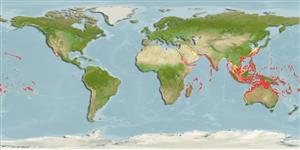Common names from other countries
Environment: milieu / climate zone / depth range / distribution range
экология
морской ассоциированный с рифами; пределы глубины 1 - 113 m (Ref. 90102). Tropical; 33°N - 34°S, 32°E - 109°W
Indo-Pacific: Red Sea, East Africa, Comoro Islands and Mascarenes, east to the Hawaiian Islands, Line Islands and Pitcairn Group, north to southern Japan, south to Joseph Bonaparte Gulf (northern in front of Western Australia), New South Wales (Australia), Lord Howe, Norfolk, Kermadec Islands, New Caledonia, Tonga and Gambier Islands (Ref. 86817). Reported from Easter Island (Ref. 89467). Records from Eastern Pacific in Mexico and Panama need further confirmation.
Length at first maturity / Size / Вес / Возраст
Maturity: Lm 24.0, range 21 - ? cm
Max length : 39.8 cm FL самец/пол неопределен; (Ref. 125599); common length : 25.0 cm TL самец/пол неопределен; (Ref. 30573); наибольший вес (опубликованные данные): 1.1 kg (Ref. 125599)
колючие лучи спинного плавника (общее число) : 8; членистые (мягкие) лучи спинного плавника (общее число) : 9; колючие лучи анального плавника: 1; членистые (мягкие) лучи анального плавника: 7. Back red-orange, sides and belly whitish; yellow longitudinal band present; no dark blotch on under middle of 1st dorsal fin (Ref. 5405). All fins yellow (Ref. 48636). Head length 2.9-3.4 in SL, length of snout 2.2.-2.6 and barbel 1.2-1.5 in HL. Body depth 3.4-4.5 in SL. (Ref. 90102)
This occasionally schooling species inhabits sandy bottoms of reef flats, lagoons, coastal and seaward reefs (Ref. 9710, 90102). Benthopelagic (Ref. 58302). In large inactive aggregations by day, dispersing to sand flats to feed at night (Ref. 9710). Sometimes mixes with blue-striped snapper Lutjanus kasmira and shows blue stripes (Ref. 48636). Feeds on small worms and crustaceans. Also caught using ringnets (Ref. 5213). Minimum depth reported taken from Ref. 30874.
Life cycle and mating behavior
Maturities | размножение | Spawnings | Egg(s) | Fecundities | личинки
Myers, R.F., 1991. Micronesian reef fishes. Second Ed. Coral Graphics, Barrigada, Guam. 298 p. (Ref. 1602)
Статус Красного Списка МСОП (Ref. 130435)
CITES (Ref. 128078)
Not Evaluated
Угроза для людей
Harmless
Использование человеком
рыболовство: коммерческий; объект спортивного рыболовства: да
дополнительная информация
инструменты
Специальные отчеты
Скачать в формате XML
ресурсы в Интернет
Estimates based on models
Preferred temperature (Ref.
115969): 24.3 - 28.9, mean 27.7 (based on 1376 cells).
Phylogenetic diversity index (Ref.
82804): PD
50 = 0.5078 [Uniqueness, from 0.5 = low to 2.0 = high].
Bayesian length-weight: a=0.01023 (0.00888 - 0.01180), b=3.09 (3.05 - 3.13), in cm Total Length, based on LWR estimates for this species (Ref.
93245).
Trophic level (Ref.
69278): 3.9 ±0.44 se; based on food items.
устойчивость к внешним воздействиям (Ref.
120179): средний (среднего размера), минимальное время удвоения популяции 1.4-4.4 года (K=0.20-0.97).
Fishing Vulnerability (Ref.
59153): Low vulnerability (24 of 100).
